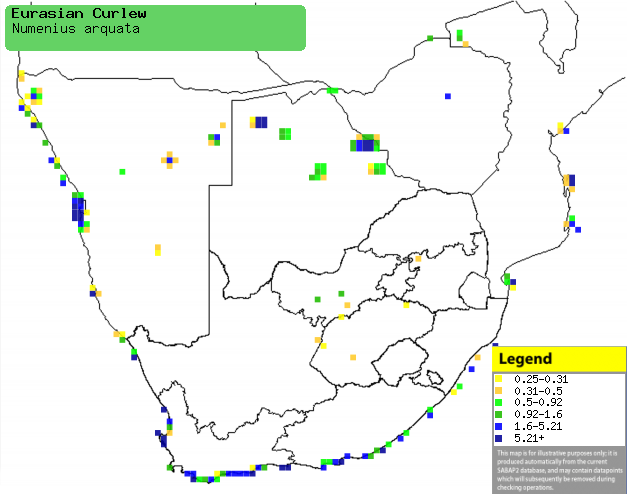|
Numenius arquata (Eurasian
curlew, Curlew)
Grootwulp [Afrikaans]; Keooe [South Sotho]; Wulp [Dutch];
Courlis cendré [French]; Großer brachvogel [German]; Maçarico-real
[Portuguese]
Life
> Eukaryotes >
Opisthokonta
> Metazoa (animals) >
Bilateria >
Deuterostomia > Chordata >
Craniata > Vertebrata (vertebrates) > Gnathostomata (jawed
vertebrates) > Teleostomi (teleost fish) > Osteichthyes (bony fish) > Class:
Sarcopterygii (lobe-finned
fish) > Stegocephalia (terrestrial
vertebrates) > Tetrapoda
(four-legged vertebrates) > Reptiliomorpha > Amniota >
Reptilia (reptiles) >
Romeriida > Diapsida > Archosauromorpha > Archosauria >
Dinosauria
(dinosaurs) > Saurischia > Theropoda (bipedal predatory dinosaurs) >
Coelurosauria > Maniraptora > Aves
(birds) >
Order: Charadriiformes > Family: Scolopacidae
Distribution and habitat
Breeds from western Europe to north-west China between
45-70° North, dispersing in the non-breeding season to the coasts and shores of
lakes in southern and western Europe, southern and South-East Asia, Madagascar
and the coast of Africa down to southern Africa. Here it is generally
uncommon along the coastline of the region, as well as further inland in
north-central Namibia and Botswana. It generally prefers coastal wetlands,
feeding on mud and sandflats then moving to roost at adjacent salt marshes, sand
dunes, mangroves and rocks.
|
 |
|
Distribution of Eurasian curlew in southern Africa,
based on statistical smoothing of the records from first SA Bird Atlas
Project (©
Animal Demography unit, University of
Cape Town; smoothing by Birgit Erni and Francesca Little). Colours range
from dark blue (most common) through to yellow (least common).
See here for the latest distribution
from the SABAP2. |
Movements and migrations
Departs its breeding grounds in June and July,
heading south and eventually arriving in southern Africa in August,
staying until about March and early April.
Food
It mainly eats aquatic invertebrates, such as shellfish,
mudprawns (such as Estuarine mudprawns Upogebia africana), small crabs,
shrimps and polychaete worms, occasionally supplemented with insects, small
vertebrates and plant matter. It does most of its foraging by using its long
bill to probe and peck soft mud, soil and grass tussocks in search of food.
Threats
Not threatened, although its numbers in southern Africa
have decreased since 1900.
References
-
Hockey PAR, Dean WRJ and Ryan PG 2005. Roberts
- Birds of southern Africa, VIIth ed. The Trustees of the John Voelcker
Bird Book Fund, Cape Town.
|
